MSc Project: A Research of Emerging Risks with Online Card Details
VerifiedAdded on 2020/05/16
|8
|2711
|190
Project
AI Summary
This project is a comprehensive research study focused on identifying and analyzing the emerging risks associated with using card details online. The project examines the rapid changes in online payment services driven by technological innovations, particularly mobile payments. It explores various risks such as data interception, misuse of card information, and fraudulent activities in e-commerce. The study aims to identify these risks, develop a risk management plan, and analyze the influence of online transaction experiences on customer risk perceptions and purchase intentions. The project includes objectives to examine the influence of online transaction experiences on risk perception, identify risks associated with sharing card details, and provide a risk management plan for mitigating these risks. It also addresses legal, social, and ethical issues related to data protection and privacy. The project outlines the resources, people involved, critical success factors, and a detailed risk management plan to address potential threats such as unsecured emails, unsecured websites, and lack of security software. References to academic papers and reports support the research.
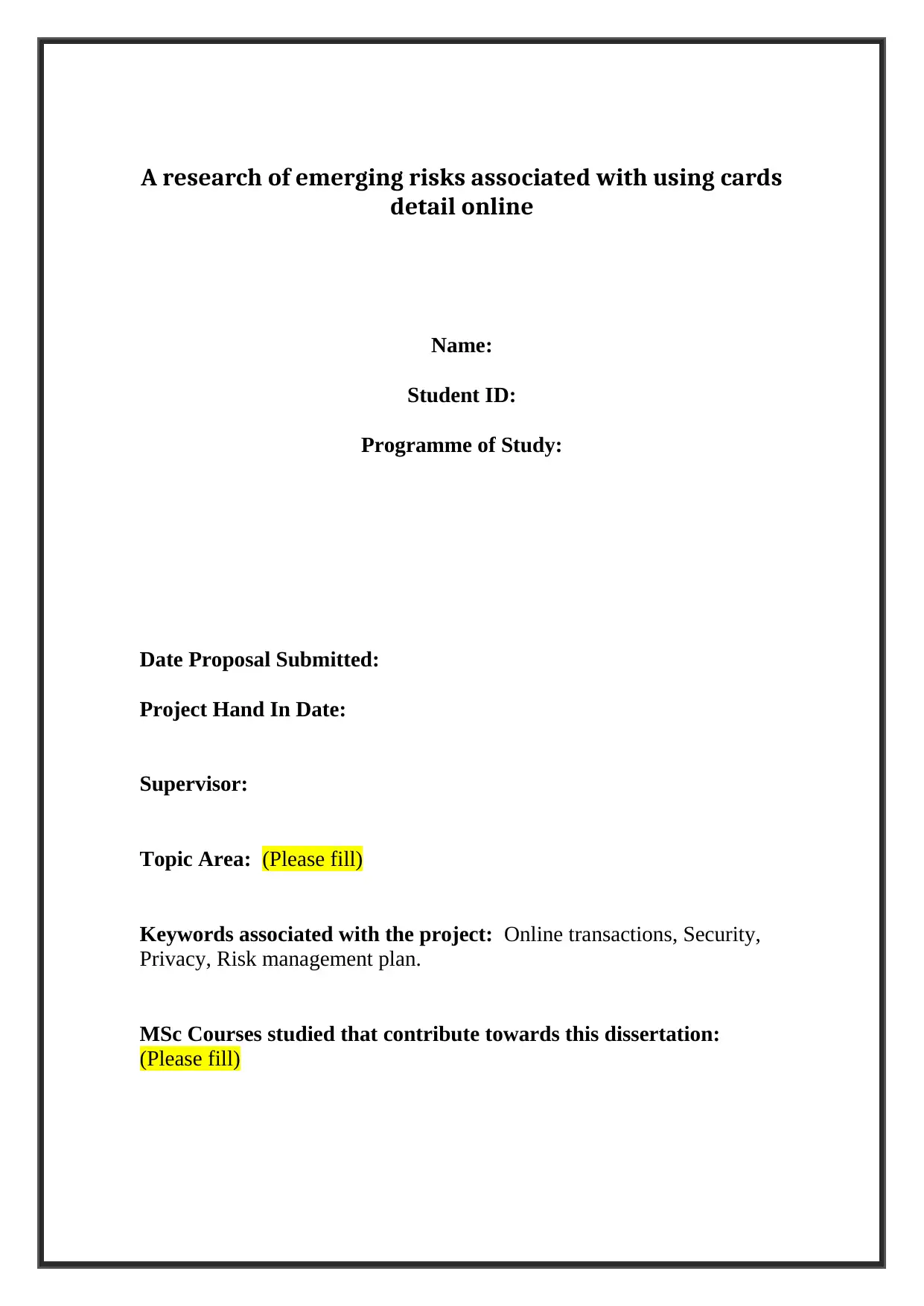
A research of emerging risks associated with using cards
detail online
Name:
Student ID:
Programme of Study:
Date Proposal Submitted:
Project Hand In Date:
Supervisor:
Topic Area: (Please fill)
Keywords associated with the project: Online transactions, Security,
Privacy, Risk management plan.
MSc Courses studied that contribute towards this dissertation:
(Please fill)
detail online
Name:
Student ID:
Programme of Study:
Date Proposal Submitted:
Project Hand In Date:
Supervisor:
Topic Area: (Please fill)
Keywords associated with the project: Online transactions, Security,
Privacy, Risk management plan.
MSc Courses studied that contribute towards this dissertation:
(Please fill)
Paraphrase This Document
Need a fresh take? Get an instant paraphrase of this document with our AI Paraphraser
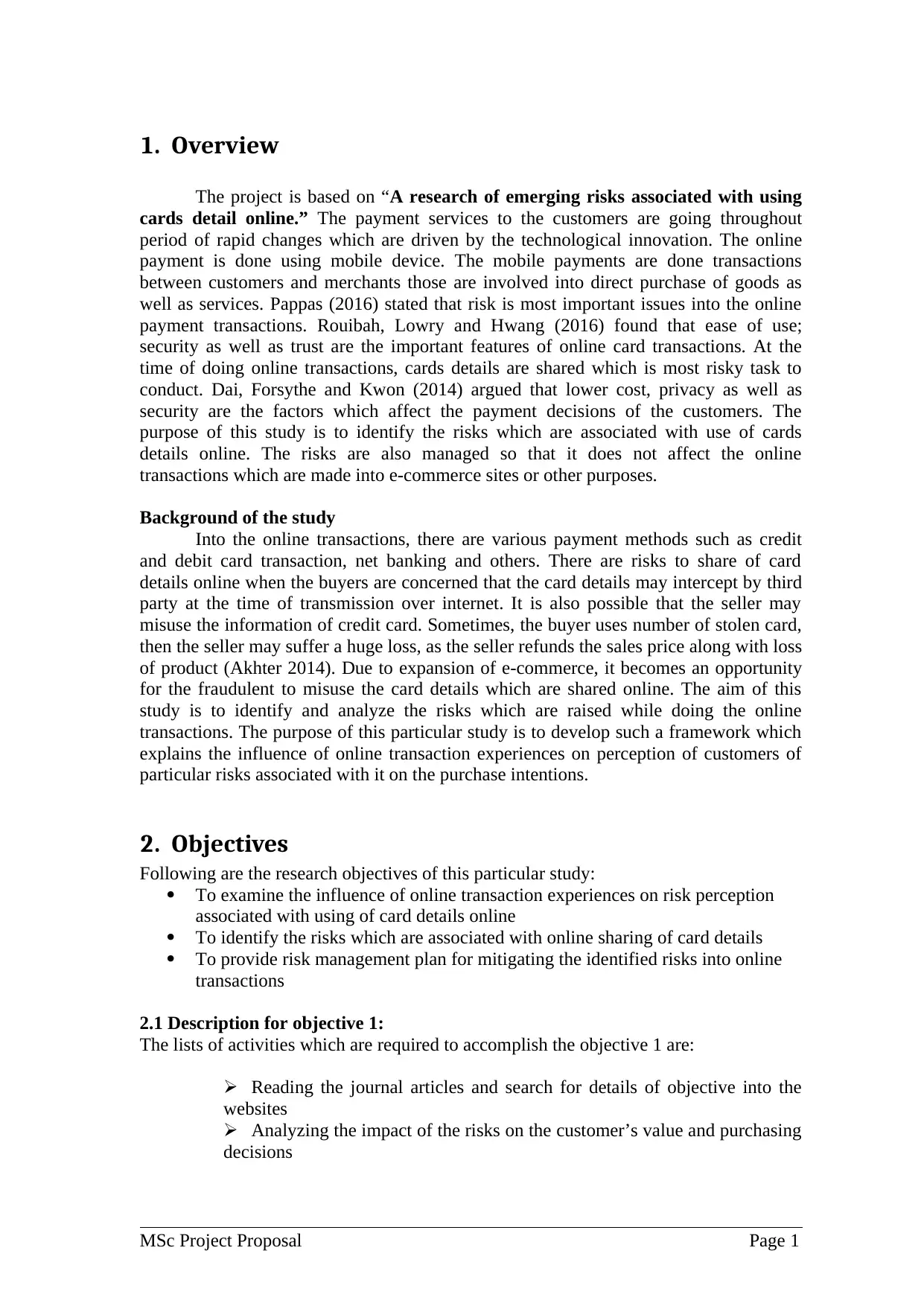
1. Overview
The project is based on “A research of emerging risks associated with using
cards detail online.” The payment services to the customers are going throughout
period of rapid changes which are driven by the technological innovation. The online
payment is done using mobile device. The mobile payments are done transactions
between customers and merchants those are involved into direct purchase of goods as
well as services. Pappas (2016) stated that risk is most important issues into the online
payment transactions. Rouibah, Lowry and Hwang (2016) found that ease of use;
security as well as trust are the important features of online card transactions. At the
time of doing online transactions, cards details are shared which is most risky task to
conduct. Dai, Forsythe and Kwon (2014) argued that lower cost, privacy as well as
security are the factors which affect the payment decisions of the customers. The
purpose of this study is to identify the risks which are associated with use of cards
details online. The risks are also managed so that it does not affect the online
transactions which are made into e-commerce sites or other purposes.
Background of the study
Into the online transactions, there are various payment methods such as credit
and debit card transaction, net banking and others. There are risks to share of card
details online when the buyers are concerned that the card details may intercept by third
party at the time of transmission over internet. It is also possible that the seller may
misuse the information of credit card. Sometimes, the buyer uses number of stolen card,
then the seller may suffer a huge loss, as the seller refunds the sales price along with loss
of product (Akhter 2014). Due to expansion of e-commerce, it becomes an opportunity
for the fraudulent to misuse the card details which are shared online. The aim of this
study is to identify and analyze the risks which are raised while doing the online
transactions. The purpose of this particular study is to develop such a framework which
explains the influence of online transaction experiences on perception of customers of
particular risks associated with it on the purchase intentions.
2. Objectives
Following are the research objectives of this particular study:
To examine the influence of online transaction experiences on risk perception
associated with using of card details online
To identify the risks which are associated with online sharing of card details
To provide risk management plan for mitigating the identified risks into online
transactions
2.1 Description for objective 1:
The lists of activities which are required to accomplish the objective 1 are:
Reading the journal articles and search for details of objective into the
websites
Analyzing the impact of the risks on the customer’s value and purchasing
decisions
MSc Project Proposal Page 1
The project is based on “A research of emerging risks associated with using
cards detail online.” The payment services to the customers are going throughout
period of rapid changes which are driven by the technological innovation. The online
payment is done using mobile device. The mobile payments are done transactions
between customers and merchants those are involved into direct purchase of goods as
well as services. Pappas (2016) stated that risk is most important issues into the online
payment transactions. Rouibah, Lowry and Hwang (2016) found that ease of use;
security as well as trust are the important features of online card transactions. At the
time of doing online transactions, cards details are shared which is most risky task to
conduct. Dai, Forsythe and Kwon (2014) argued that lower cost, privacy as well as
security are the factors which affect the payment decisions of the customers. The
purpose of this study is to identify the risks which are associated with use of cards
details online. The risks are also managed so that it does not affect the online
transactions which are made into e-commerce sites or other purposes.
Background of the study
Into the online transactions, there are various payment methods such as credit
and debit card transaction, net banking and others. There are risks to share of card
details online when the buyers are concerned that the card details may intercept by third
party at the time of transmission over internet. It is also possible that the seller may
misuse the information of credit card. Sometimes, the buyer uses number of stolen card,
then the seller may suffer a huge loss, as the seller refunds the sales price along with loss
of product (Akhter 2014). Due to expansion of e-commerce, it becomes an opportunity
for the fraudulent to misuse the card details which are shared online. The aim of this
study is to identify and analyze the risks which are raised while doing the online
transactions. The purpose of this particular study is to develop such a framework which
explains the influence of online transaction experiences on perception of customers of
particular risks associated with it on the purchase intentions.
2. Objectives
Following are the research objectives of this particular study:
To examine the influence of online transaction experiences on risk perception
associated with using of card details online
To identify the risks which are associated with online sharing of card details
To provide risk management plan for mitigating the identified risks into online
transactions
2.1 Description for objective 1:
The lists of activities which are required to accomplish the objective 1 are:
Reading the journal articles and search for details of objective into the
websites
Analyzing the impact of the risks on the customer’s value and purchasing
decisions
MSc Project Proposal Page 1
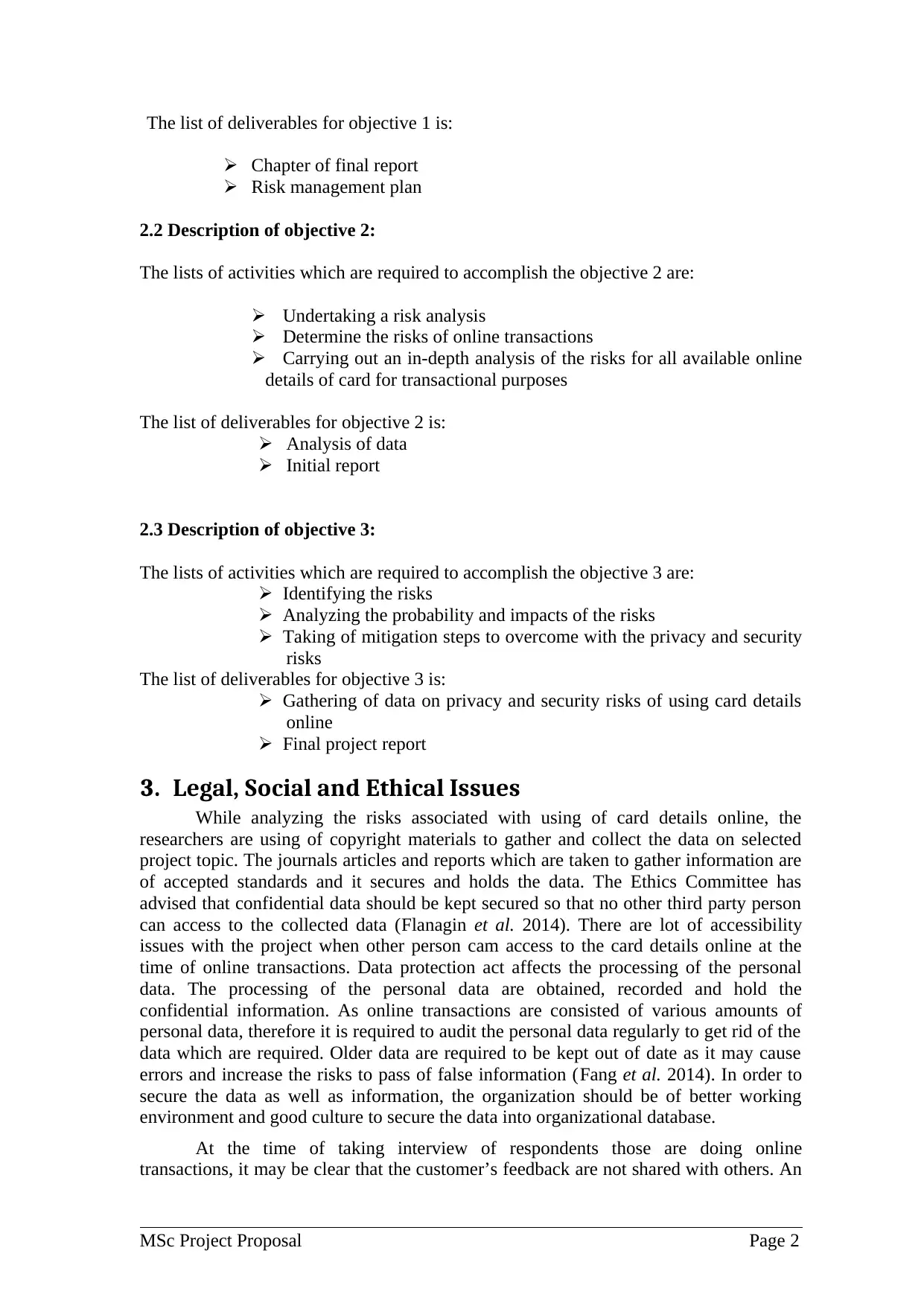
The list of deliverables for objective 1 is:
Chapter of final report
Risk management plan
2.2 Description of objective 2:
The lists of activities which are required to accomplish the objective 2 are:
Undertaking a risk analysis
Determine the risks of online transactions
Carrying out an in-depth analysis of the risks for all available online
details of card for transactional purposes
The list of deliverables for objective 2 is:
Analysis of data
Initial report
2.3 Description of objective 3:
The lists of activities which are required to accomplish the objective 3 are:
Identifying the risks
Analyzing the probability and impacts of the risks
Taking of mitigation steps to overcome with the privacy and security
risks
The list of deliverables for objective 3 is:
Gathering of data on privacy and security risks of using card details
online
Final project report
3. Legal, Social and Ethical Issues
While analyzing the risks associated with using of card details online, the
researchers are using of copyright materials to gather and collect the data on selected
project topic. The journals articles and reports which are taken to gather information are
of accepted standards and it secures and holds the data. The Ethics Committee has
advised that confidential data should be kept secured so that no other third party person
can access to the collected data (Flanagin et al. 2014). There are lot of accessibility
issues with the project when other person cam access to the card details online at the
time of online transactions. Data protection act affects the processing of the personal
data. The processing of the personal data are obtained, recorded and hold the
confidential information. As online transactions are consisted of various amounts of
personal data, therefore it is required to audit the personal data regularly to get rid of the
data which are required. Older data are required to be kept out of date as it may cause
errors and increase the risks to pass of false information (Fang et al. 2014). In order to
secure the data as well as information, the organization should be of better working
environment and good culture to secure the data into organizational database.
At the time of taking interview of respondents those are doing online
transactions, it may be clear that the customer’s feedback are not shared with others. An
MSc Project Proposal Page 2
Chapter of final report
Risk management plan
2.2 Description of objective 2:
The lists of activities which are required to accomplish the objective 2 are:
Undertaking a risk analysis
Determine the risks of online transactions
Carrying out an in-depth analysis of the risks for all available online
details of card for transactional purposes
The list of deliverables for objective 2 is:
Analysis of data
Initial report
2.3 Description of objective 3:
The lists of activities which are required to accomplish the objective 3 are:
Identifying the risks
Analyzing the probability and impacts of the risks
Taking of mitigation steps to overcome with the privacy and security
risks
The list of deliverables for objective 3 is:
Gathering of data on privacy and security risks of using card details
online
Final project report
3. Legal, Social and Ethical Issues
While analyzing the risks associated with using of card details online, the
researchers are using of copyright materials to gather and collect the data on selected
project topic. The journals articles and reports which are taken to gather information are
of accepted standards and it secures and holds the data. The Ethics Committee has
advised that confidential data should be kept secured so that no other third party person
can access to the collected data (Flanagin et al. 2014). There are lot of accessibility
issues with the project when other person cam access to the card details online at the
time of online transactions. Data protection act affects the processing of the personal
data. The processing of the personal data are obtained, recorded and hold the
confidential information. As online transactions are consisted of various amounts of
personal data, therefore it is required to audit the personal data regularly to get rid of the
data which are required. Older data are required to be kept out of date as it may cause
errors and increase the risks to pass of false information (Fang et al. 2014). In order to
secure the data as well as information, the organization should be of better working
environment and good culture to secure the data into organizational database.
At the time of taking interview of respondents those are doing online
transactions, it may be clear that the customer’s feedback are not shared with others. An
MSc Project Proposal Page 2
⊘ This is a preview!⊘
Do you want full access?
Subscribe today to unlock all pages.

Trusted by 1+ million students worldwide
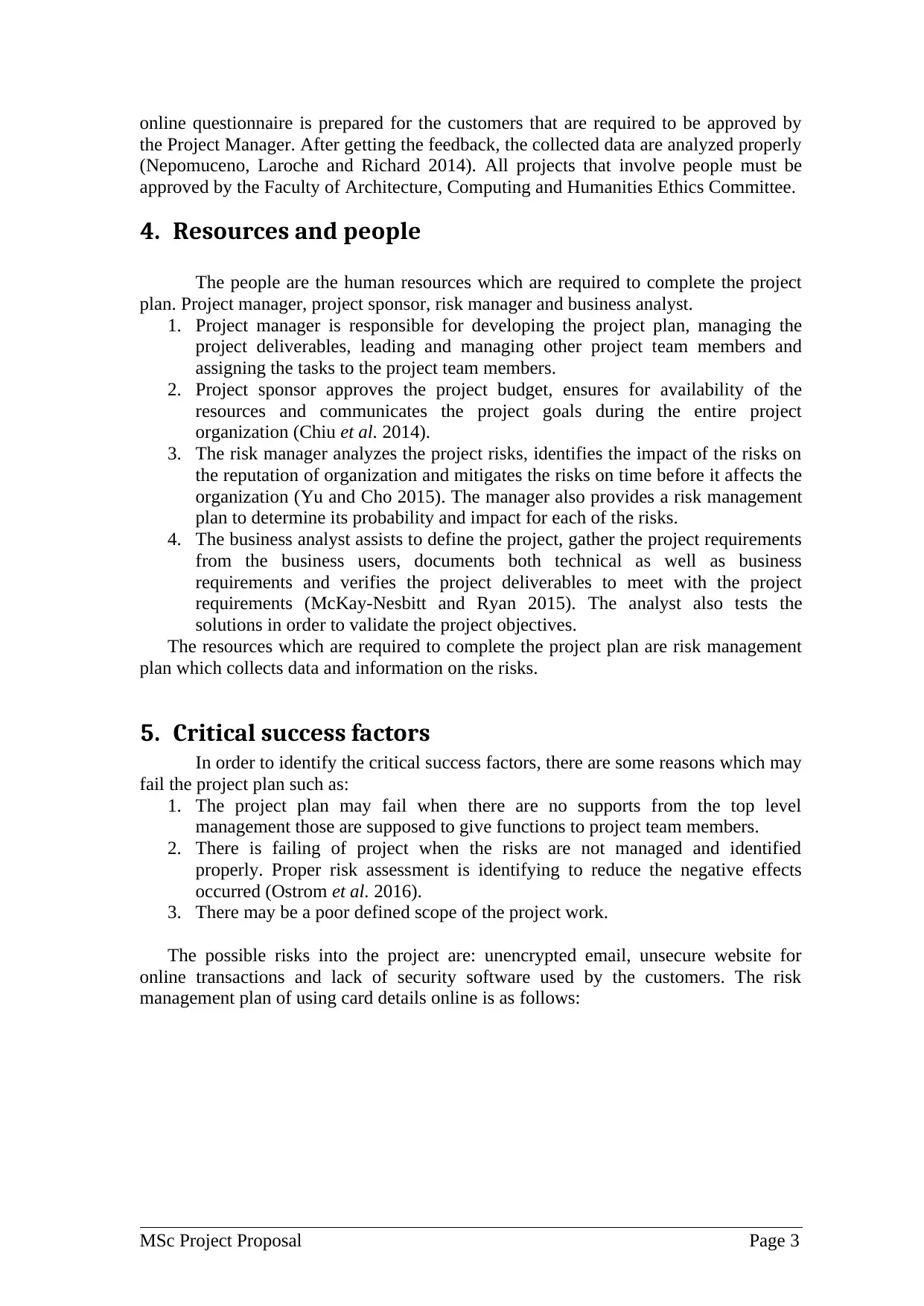
online questionnaire is prepared for the customers that are required to be approved by
the Project Manager. After getting the feedback, the collected data are analyzed properly
(Nepomuceno, Laroche and Richard 2014). All projects that involve people must be
approved by the Faculty of Architecture, Computing and Humanities Ethics Committee.
4. Resources and people
The people are the human resources which are required to complete the project
plan. Project manager, project sponsor, risk manager and business analyst.
1. Project manager is responsible for developing the project plan, managing the
project deliverables, leading and managing other project team members and
assigning the tasks to the project team members.
2. Project sponsor approves the project budget, ensures for availability of the
resources and communicates the project goals during the entire project
organization (Chiu et al. 2014).
3. The risk manager analyzes the project risks, identifies the impact of the risks on
the reputation of organization and mitigates the risks on time before it affects the
organization (Yu and Cho 2015). The manager also provides a risk management
plan to determine its probability and impact for each of the risks.
4. The business analyst assists to define the project, gather the project requirements
from the business users, documents both technical as well as business
requirements and verifies the project deliverables to meet with the project
requirements (McKay-Nesbitt and Ryan 2015). The analyst also tests the
solutions in order to validate the project objectives.
The resources which are required to complete the project plan are risk management
plan which collects data and information on the risks.
5. Critical success factors
In order to identify the critical success factors, there are some reasons which may
fail the project plan such as:
1. The project plan may fail when there are no supports from the top level
management those are supposed to give functions to project team members.
2. There is failing of project when the risks are not managed and identified
properly. Proper risk assessment is identifying to reduce the negative effects
occurred (Ostrom et al. 2016).
3. There may be a poor defined scope of the project work.
The possible risks into the project are: unencrypted email, unsecure website for
online transactions and lack of security software used by the customers. The risk
management plan of using card details online is as follows:
MSc Project Proposal Page 3
the Project Manager. After getting the feedback, the collected data are analyzed properly
(Nepomuceno, Laroche and Richard 2014). All projects that involve people must be
approved by the Faculty of Architecture, Computing and Humanities Ethics Committee.
4. Resources and people
The people are the human resources which are required to complete the project
plan. Project manager, project sponsor, risk manager and business analyst.
1. Project manager is responsible for developing the project plan, managing the
project deliverables, leading and managing other project team members and
assigning the tasks to the project team members.
2. Project sponsor approves the project budget, ensures for availability of the
resources and communicates the project goals during the entire project
organization (Chiu et al. 2014).
3. The risk manager analyzes the project risks, identifies the impact of the risks on
the reputation of organization and mitigates the risks on time before it affects the
organization (Yu and Cho 2015). The manager also provides a risk management
plan to determine its probability and impact for each of the risks.
4. The business analyst assists to define the project, gather the project requirements
from the business users, documents both technical as well as business
requirements and verifies the project deliverables to meet with the project
requirements (McKay-Nesbitt and Ryan 2015). The analyst also tests the
solutions in order to validate the project objectives.
The resources which are required to complete the project plan are risk management
plan which collects data and information on the risks.
5. Critical success factors
In order to identify the critical success factors, there are some reasons which may
fail the project plan such as:
1. The project plan may fail when there are no supports from the top level
management those are supposed to give functions to project team members.
2. There is failing of project when the risks are not managed and identified
properly. Proper risk assessment is identifying to reduce the negative effects
occurred (Ostrom et al. 2016).
3. There may be a poor defined scope of the project work.
The possible risks into the project are: unencrypted email, unsecure website for
online transactions and lack of security software used by the customers. The risk
management plan of using card details online is as follows:
MSc Project Proposal Page 3
Paraphrase This Document
Need a fresh take? Get an instant paraphrase of this document with our AI Paraphraser
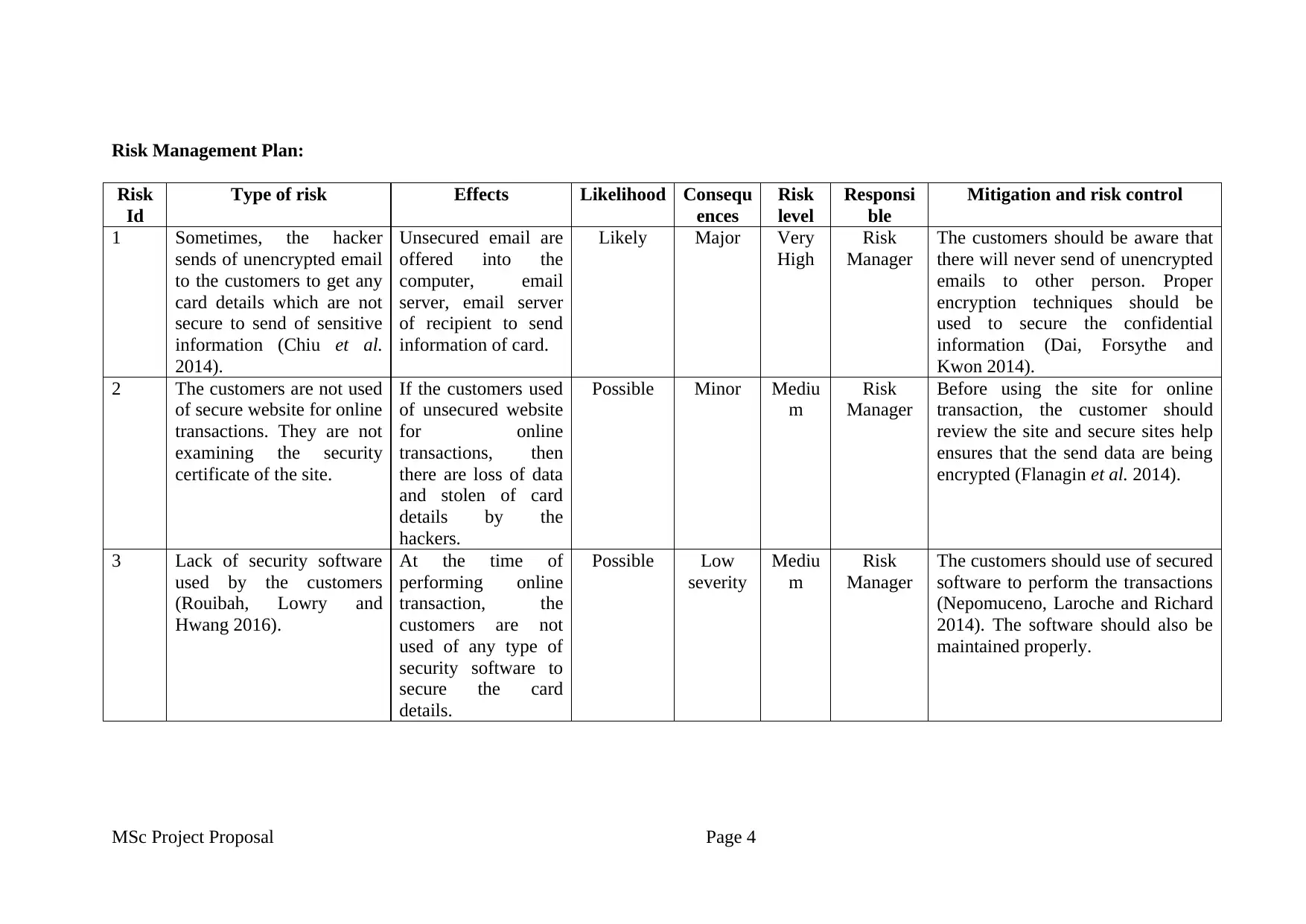
Risk Management Plan:
Risk
Id
Type of risk Effects Likelihood Consequ
ences
Risk
level
Responsi
ble
Mitigation and risk control
1 Sometimes, the hacker
sends of unencrypted email
to the customers to get any
card details which are not
secure to send of sensitive
information (Chiu et al.
2014).
Unsecured email are
offered into the
computer, email
server, email server
of recipient to send
information of card.
Likely Major Very
High
Risk
Manager
The customers should be aware that
there will never send of unencrypted
emails to other person. Proper
encryption techniques should be
used to secure the confidential
information (Dai, Forsythe and
Kwon 2014).
2 The customers are not used
of secure website for online
transactions. They are not
examining the security
certificate of the site.
If the customers used
of unsecured website
for online
transactions, then
there are loss of data
and stolen of card
details by the
hackers.
Possible Minor Mediu
m
Risk
Manager
Before using the site for online
transaction, the customer should
review the site and secure sites help
ensures that the send data are being
encrypted (Flanagin et al. 2014).
3 Lack of security software
used by the customers
(Rouibah, Lowry and
Hwang 2016).
At the time of
performing online
transaction, the
customers are not
used of any type of
security software to
secure the card
details.
Possible Low
severity
Mediu
m
Risk
Manager
The customers should use of secured
software to perform the transactions
(Nepomuceno, Laroche and Richard
2014). The software should also be
maintained properly.
MSc Project Proposal Page 4
Risk
Id
Type of risk Effects Likelihood Consequ
ences
Risk
level
Responsi
ble
Mitigation and risk control
1 Sometimes, the hacker
sends of unencrypted email
to the customers to get any
card details which are not
secure to send of sensitive
information (Chiu et al.
2014).
Unsecured email are
offered into the
computer, email
server, email server
of recipient to send
information of card.
Likely Major Very
High
Risk
Manager
The customers should be aware that
there will never send of unencrypted
emails to other person. Proper
encryption techniques should be
used to secure the confidential
information (Dai, Forsythe and
Kwon 2014).
2 The customers are not used
of secure website for online
transactions. They are not
examining the security
certificate of the site.
If the customers used
of unsecured website
for online
transactions, then
there are loss of data
and stolen of card
details by the
hackers.
Possible Minor Mediu
m
Risk
Manager
Before using the site for online
transaction, the customer should
review the site and secure sites help
ensures that the send data are being
encrypted (Flanagin et al. 2014).
3 Lack of security software
used by the customers
(Rouibah, Lowry and
Hwang 2016).
At the time of
performing online
transaction, the
customers are not
used of any type of
security software to
secure the card
details.
Possible Low
severity
Mediu
m
Risk
Manager
The customers should use of secured
software to perform the transactions
(Nepomuceno, Laroche and Richard
2014). The software should also be
maintained properly.
MSc Project Proposal Page 4
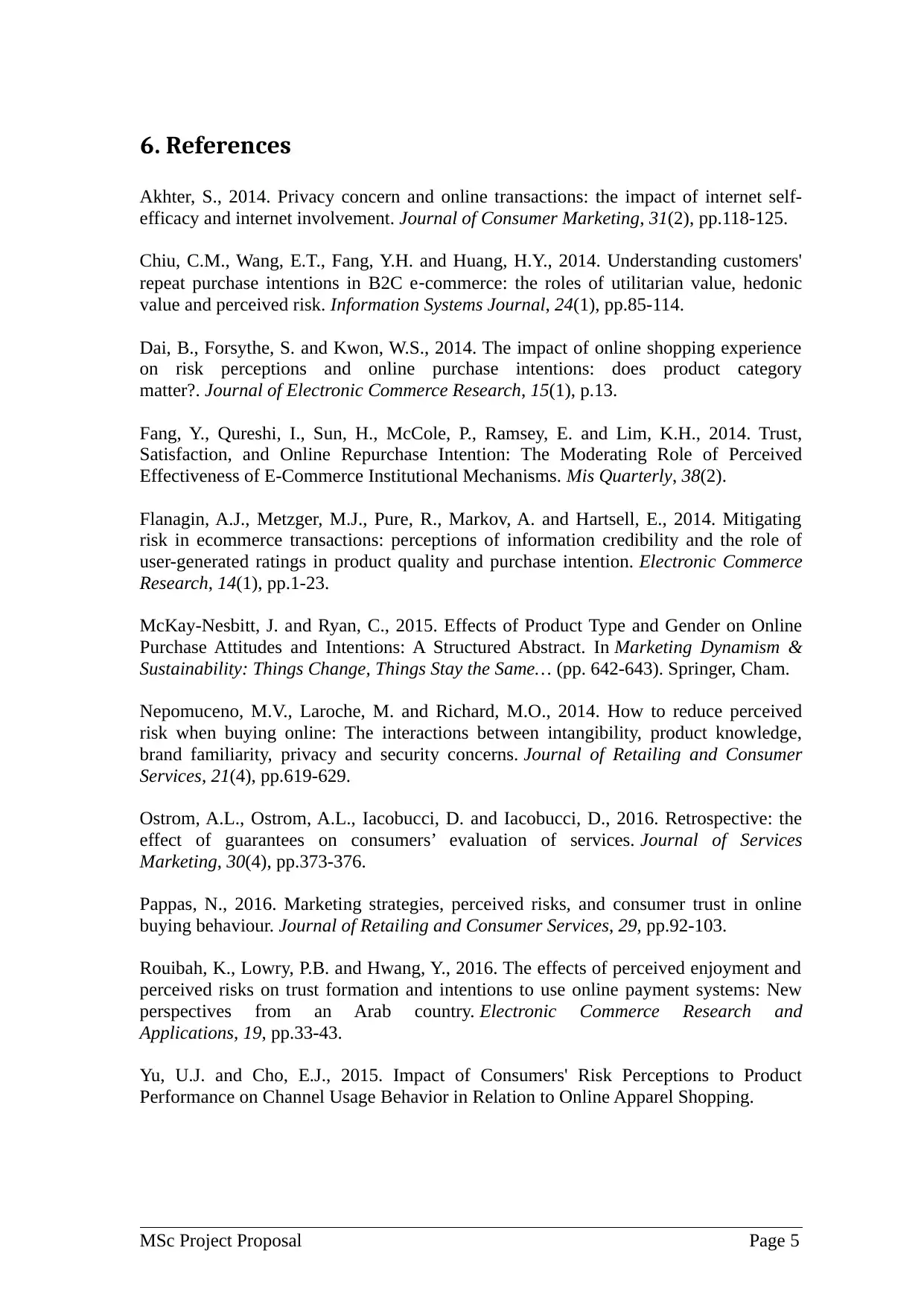
6. References
Akhter, S., 2014. Privacy concern and online transactions: the impact of internet self-
efficacy and internet involvement. Journal of Consumer Marketing, 31(2), pp.118-125.
Chiu, C.M., Wang, E.T., Fang, Y.H. and Huang, H.Y., 2014. Understanding customers'
repeat purchase intentions in B2C e‐commerce: the roles of utilitarian value, hedonic
value and perceived risk. Information Systems Journal, 24(1), pp.85-114.
Dai, B., Forsythe, S. and Kwon, W.S., 2014. The impact of online shopping experience
on risk perceptions and online purchase intentions: does product category
matter?. Journal of Electronic Commerce Research, 15(1), p.13.
Fang, Y., Qureshi, I., Sun, H., McCole, P., Ramsey, E. and Lim, K.H., 2014. Trust,
Satisfaction, and Online Repurchase Intention: The Moderating Role of Perceived
Effectiveness of E-Commerce Institutional Mechanisms. Mis Quarterly, 38(2).
Flanagin, A.J., Metzger, M.J., Pure, R., Markov, A. and Hartsell, E., 2014. Mitigating
risk in ecommerce transactions: perceptions of information credibility and the role of
user-generated ratings in product quality and purchase intention. Electronic Commerce
Research, 14(1), pp.1-23.
McKay-Nesbitt, J. and Ryan, C., 2015. Effects of Product Type and Gender on Online
Purchase Attitudes and Intentions: A Structured Abstract. In Marketing Dynamism &
Sustainability: Things Change, Things Stay the Same… (pp. 642-643). Springer, Cham.
Nepomuceno, M.V., Laroche, M. and Richard, M.O., 2014. How to reduce perceived
risk when buying online: The interactions between intangibility, product knowledge,
brand familiarity, privacy and security concerns. Journal of Retailing and Consumer
Services, 21(4), pp.619-629.
Ostrom, A.L., Ostrom, A.L., Iacobucci, D. and Iacobucci, D., 2016. Retrospective: the
effect of guarantees on consumers’ evaluation of services. Journal of Services
Marketing, 30(4), pp.373-376.
Pappas, N., 2016. Marketing strategies, perceived risks, and consumer trust in online
buying behaviour. Journal of Retailing and Consumer Services, 29, pp.92-103.
Rouibah, K., Lowry, P.B. and Hwang, Y., 2016. The effects of perceived enjoyment and
perceived risks on trust formation and intentions to use online payment systems: New
perspectives from an Arab country. Electronic Commerce Research and
Applications, 19, pp.33-43.
Yu, U.J. and Cho, E.J., 2015. Impact of Consumers' Risk Perceptions to Product
Performance on Channel Usage Behavior in Relation to Online Apparel Shopping.
MSc Project Proposal Page 5
Akhter, S., 2014. Privacy concern and online transactions: the impact of internet self-
efficacy and internet involvement. Journal of Consumer Marketing, 31(2), pp.118-125.
Chiu, C.M., Wang, E.T., Fang, Y.H. and Huang, H.Y., 2014. Understanding customers'
repeat purchase intentions in B2C e‐commerce: the roles of utilitarian value, hedonic
value and perceived risk. Information Systems Journal, 24(1), pp.85-114.
Dai, B., Forsythe, S. and Kwon, W.S., 2014. The impact of online shopping experience
on risk perceptions and online purchase intentions: does product category
matter?. Journal of Electronic Commerce Research, 15(1), p.13.
Fang, Y., Qureshi, I., Sun, H., McCole, P., Ramsey, E. and Lim, K.H., 2014. Trust,
Satisfaction, and Online Repurchase Intention: The Moderating Role of Perceived
Effectiveness of E-Commerce Institutional Mechanisms. Mis Quarterly, 38(2).
Flanagin, A.J., Metzger, M.J., Pure, R., Markov, A. and Hartsell, E., 2014. Mitigating
risk in ecommerce transactions: perceptions of information credibility and the role of
user-generated ratings in product quality and purchase intention. Electronic Commerce
Research, 14(1), pp.1-23.
McKay-Nesbitt, J. and Ryan, C., 2015. Effects of Product Type and Gender on Online
Purchase Attitudes and Intentions: A Structured Abstract. In Marketing Dynamism &
Sustainability: Things Change, Things Stay the Same… (pp. 642-643). Springer, Cham.
Nepomuceno, M.V., Laroche, M. and Richard, M.O., 2014. How to reduce perceived
risk when buying online: The interactions between intangibility, product knowledge,
brand familiarity, privacy and security concerns. Journal of Retailing and Consumer
Services, 21(4), pp.619-629.
Ostrom, A.L., Ostrom, A.L., Iacobucci, D. and Iacobucci, D., 2016. Retrospective: the
effect of guarantees on consumers’ evaluation of services. Journal of Services
Marketing, 30(4), pp.373-376.
Pappas, N., 2016. Marketing strategies, perceived risks, and consumer trust in online
buying behaviour. Journal of Retailing and Consumer Services, 29, pp.92-103.
Rouibah, K., Lowry, P.B. and Hwang, Y., 2016. The effects of perceived enjoyment and
perceived risks on trust formation and intentions to use online payment systems: New
perspectives from an Arab country. Electronic Commerce Research and
Applications, 19, pp.33-43.
Yu, U.J. and Cho, E.J., 2015. Impact of Consumers' Risk Perceptions to Product
Performance on Channel Usage Behavior in Relation to Online Apparel Shopping.
MSc Project Proposal Page 5
⊘ This is a preview!⊘
Do you want full access?
Subscribe today to unlock all pages.

Trusted by 1+ million students worldwide
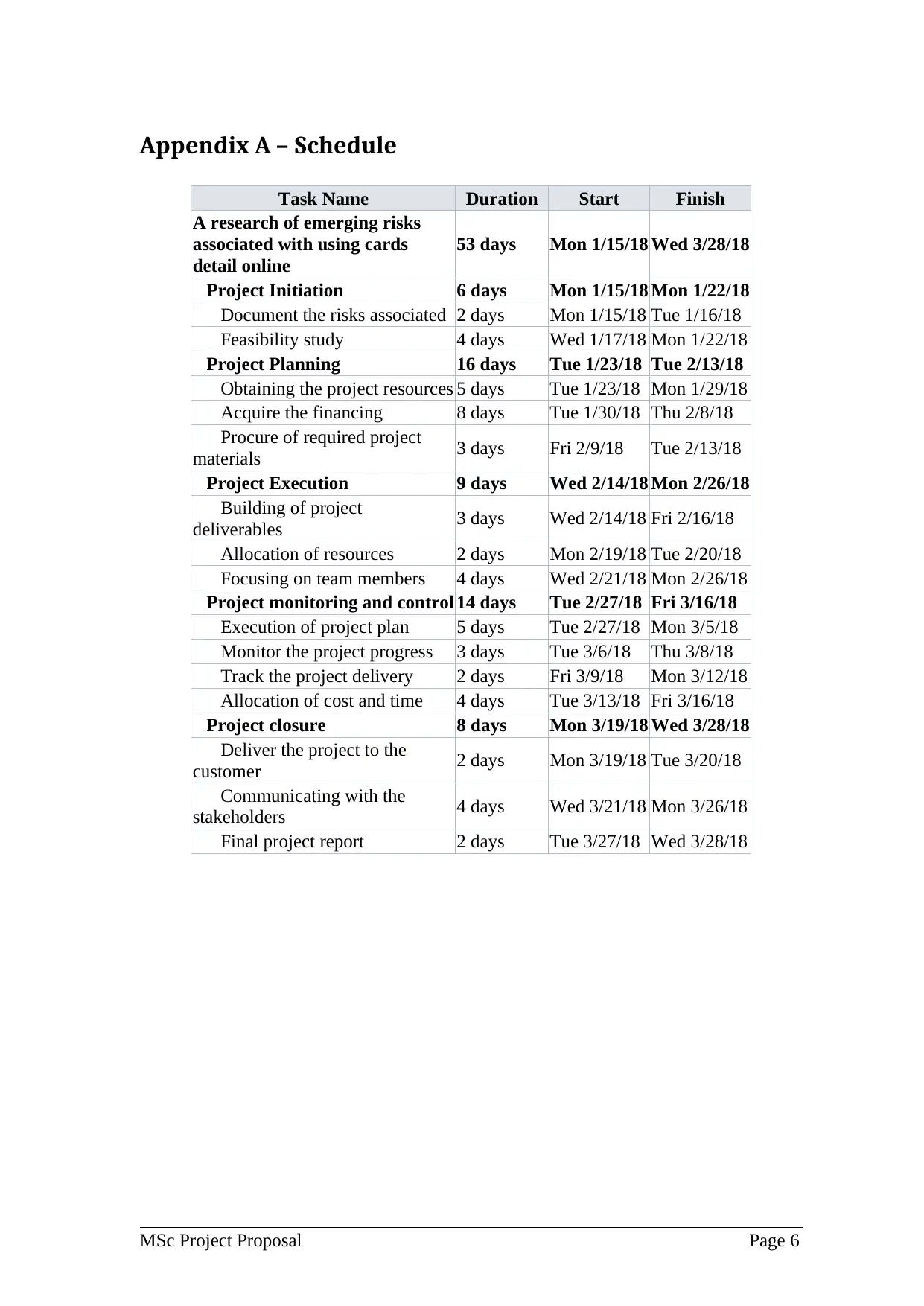
Appendix A – Schedule
Task Name Duration Start Finish
A research of emerging risks
associated with using cards
detail online
53 days Mon 1/15/18 Wed 3/28/18
Project Initiation 6 days Mon 1/15/18 Mon 1/22/18
Document the risks associated 2 days Mon 1/15/18 Tue 1/16/18
Feasibility study 4 days Wed 1/17/18 Mon 1/22/18
Project Planning 16 days Tue 1/23/18 Tue 2/13/18
Obtaining the project resources 5 days Tue 1/23/18 Mon 1/29/18
Acquire the financing 8 days Tue 1/30/18 Thu 2/8/18
Procure of required project
materials 3 days Fri 2/9/18 Tue 2/13/18
Project Execution 9 days Wed 2/14/18 Mon 2/26/18
Building of project
deliverables 3 days Wed 2/14/18 Fri 2/16/18
Allocation of resources 2 days Mon 2/19/18 Tue 2/20/18
Focusing on team members 4 days Wed 2/21/18 Mon 2/26/18
Project monitoring and control 14 days Tue 2/27/18 Fri 3/16/18
Execution of project plan 5 days Tue 2/27/18 Mon 3/5/18
Monitor the project progress 3 days Tue 3/6/18 Thu 3/8/18
Track the project delivery 2 days Fri 3/9/18 Mon 3/12/18
Allocation of cost and time 4 days Tue 3/13/18 Fri 3/16/18
Project closure 8 days Mon 3/19/18 Wed 3/28/18
Deliver the project to the
customer 2 days Mon 3/19/18 Tue 3/20/18
Communicating with the
stakeholders 4 days Wed 3/21/18 Mon 3/26/18
Final project report 2 days Tue 3/27/18 Wed 3/28/18
MSc Project Proposal Page 6
Task Name Duration Start Finish
A research of emerging risks
associated with using cards
detail online
53 days Mon 1/15/18 Wed 3/28/18
Project Initiation 6 days Mon 1/15/18 Mon 1/22/18
Document the risks associated 2 days Mon 1/15/18 Tue 1/16/18
Feasibility study 4 days Wed 1/17/18 Mon 1/22/18
Project Planning 16 days Tue 1/23/18 Tue 2/13/18
Obtaining the project resources 5 days Tue 1/23/18 Mon 1/29/18
Acquire the financing 8 days Tue 1/30/18 Thu 2/8/18
Procure of required project
materials 3 days Fri 2/9/18 Tue 2/13/18
Project Execution 9 days Wed 2/14/18 Mon 2/26/18
Building of project
deliverables 3 days Wed 2/14/18 Fri 2/16/18
Allocation of resources 2 days Mon 2/19/18 Tue 2/20/18
Focusing on team members 4 days Wed 2/21/18 Mon 2/26/18
Project monitoring and control 14 days Tue 2/27/18 Fri 3/16/18
Execution of project plan 5 days Tue 2/27/18 Mon 3/5/18
Monitor the project progress 3 days Tue 3/6/18 Thu 3/8/18
Track the project delivery 2 days Fri 3/9/18 Mon 3/12/18
Allocation of cost and time 4 days Tue 3/13/18 Fri 3/16/18
Project closure 8 days Mon 3/19/18 Wed 3/28/18
Deliver the project to the
customer 2 days Mon 3/19/18 Tue 3/20/18
Communicating with the
stakeholders 4 days Wed 3/21/18 Mon 3/26/18
Final project report 2 days Tue 3/27/18 Wed 3/28/18
MSc Project Proposal Page 6
Paraphrase This Document
Need a fresh take? Get an instant paraphrase of this document with our AI Paraphraser
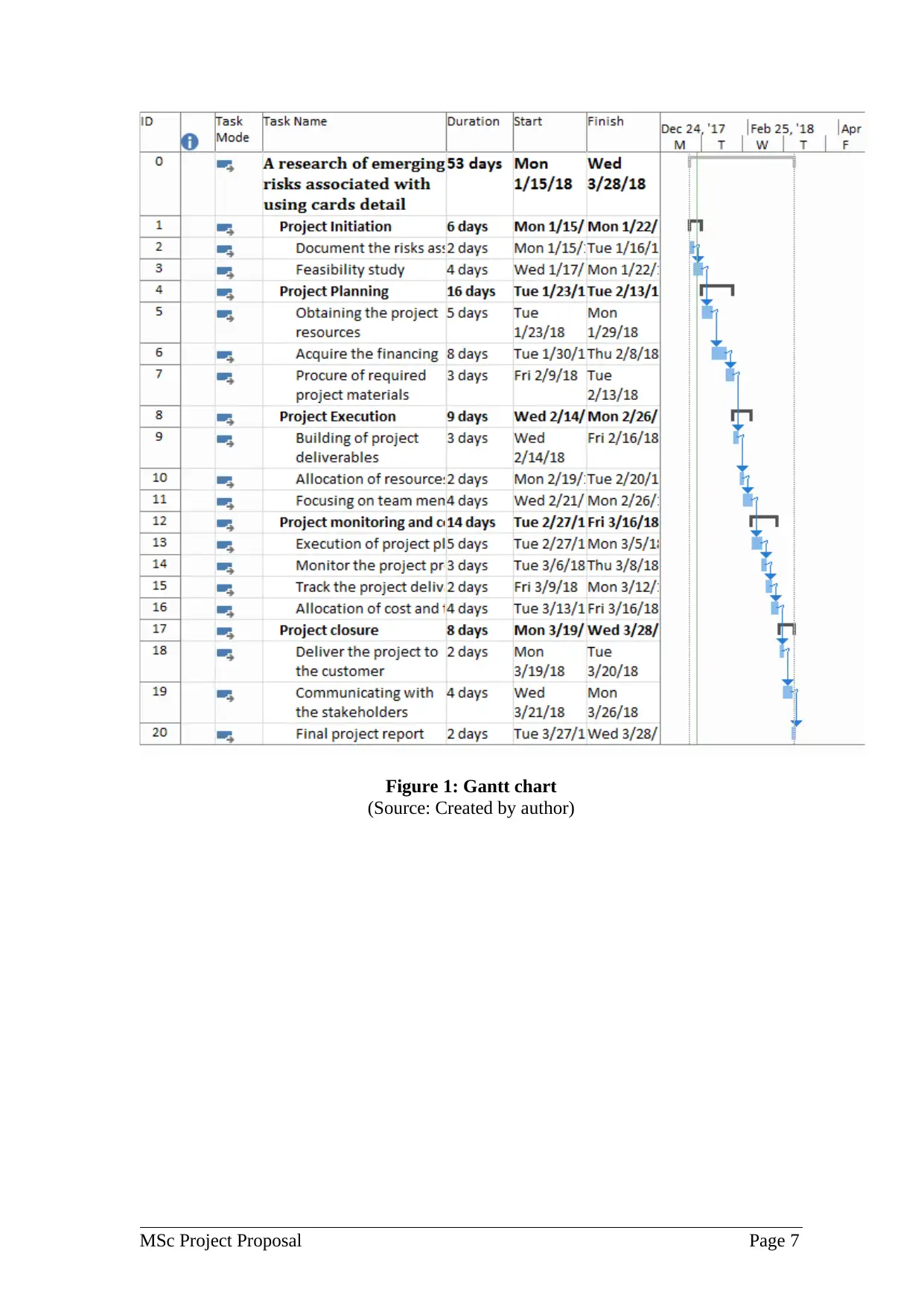
Figure 1: Gantt chart
(Source: Created by author)
MSc Project Proposal Page 7
(Source: Created by author)
MSc Project Proposal Page 7
1 out of 8
Related Documents
Your All-in-One AI-Powered Toolkit for Academic Success.
+13062052269
info@desklib.com
Available 24*7 on WhatsApp / Email
![[object Object]](/_next/static/media/star-bottom.7253800d.svg)
Unlock your academic potential
Copyright © 2020–2025 A2Z Services. All Rights Reserved. Developed and managed by ZUCOL.





